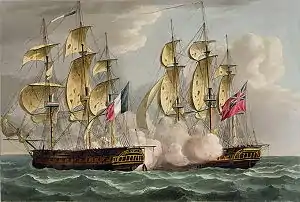French frigate Immortalité (1795)
The Immortalité was a Romaine class frigate of the French Navy.
 Capture of Immortalité by HMS Fisgard | |
| History | |
|---|---|
| Name: |
|
| Builder: | Brest, France |
| Laid down: | May 1794 |
| Launched: | 7 January 1795 |
| In service: | February 1795 |
| Fate: |
|
| Name: | Immortalite |
| Acquired: | 20 October 1798 |
| Fate: | Broken up in July 1806 |
| General characteristics | |
| Class and type: | Romaine class frigate |
| Displacement: | 700 tonnes |
| Length: | 45.5 m (149 ft) |
| Beam: | 11.8 m (39 ft) |
| Draught: | 5 m (16 ft) |
| Propulsion: | Sail |
| Armament: |
|
| Armour: | Timber |
She took part in the Expédition d'Irlande, and was captured shortly after the Battle of Tory Island by HMS Fisgard. She was recommissioned in the Royal Navy as HMS Immortalite and had an active career on the Home Station.
Napoleonic Wars
In the months before the resumption of war with France, the Navy started preparations that included impressing seamen. The crews of outbound Indiamen were an attractive target. Woodford and Ganges were sitting in the Thames in March 1803, taking their crews on board just prior to sailing. At sunset, a press gang from Immortalite rowed up to Woodford, while boats from HMS Amethyst and HMS Lynx approached Ganges. As the press gangs approached they were noticed, and the crews of both Indiamen were piped to quarters. That is, they assembled on the decks armed with pikes and cutlasses, and anything they could throw. The officers in charge of the press gangs thought this mere bravado and pulled alongside the Indiamen, only to meet a severe resistance from the crewmen, who had absolutely no desire to serve in the Royal Navy. The men from Immortalite suffered several injuries from shot and pike that were thrown at them, and eventually opened fire with muskets, killing two sailors on Woodford. Even so, the press gangs were not able to get on board either Indiaman, and eventually withdrew some distance. When Woodford's officers finally permitted the press gang from Immortalite to board, all they found on board were a few sickly sailors.[1]
Fate
Immortalite was broken up in July 1806.
External links
References
- Crawford, Abraham (1851) Reminiscences of a Naval Officer, During the Late War: With Sketches and Anecdotes of Distinguished Commanders, Volume 1. (H. Colburn).
- James, William; Chamier, Frederick (1837). The Naval History of Great Britain: From the Declaration of War by France In 1793 to the Accession of George IV. London, UK: R. Bentley. OCLC 656581450.
- Specific
- Crawford (1851), pp. 103–7.